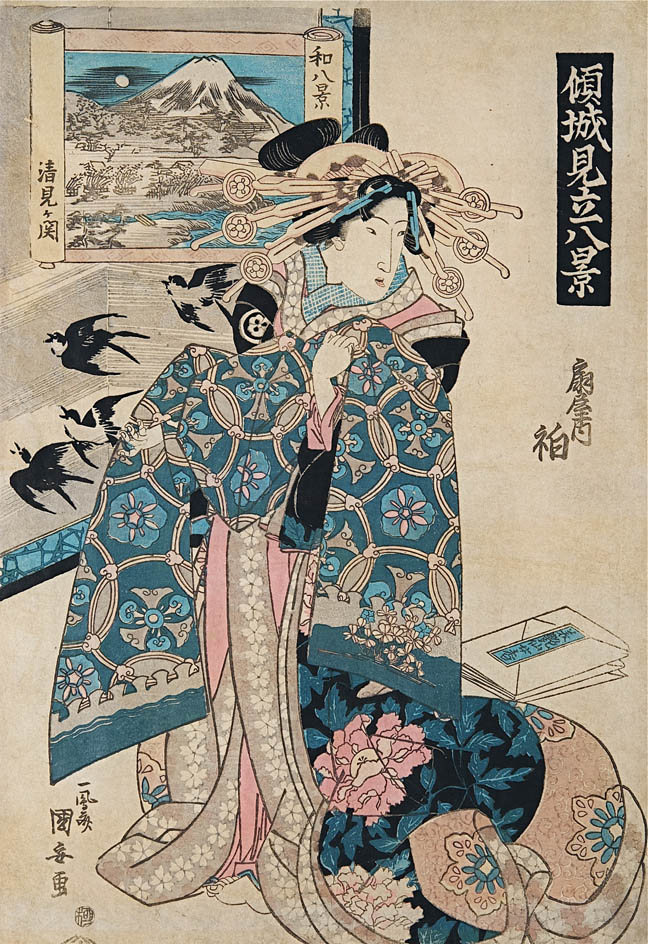

Title: Colored Japanese Woodblock print by Artist Utagawa Kuniyasu
Shipping: $29.00
Artist: N/A
Period: 18th Century
History: N/A
Origin: N/A
Condition: Museum Quality
Item Date: 1794-1832
Item ID: 3777
Utagawa Kuniyasu (Japanese, 1794-1832) A woodblock print in colors depicting a Bijin, apprx. 14-3/8" x 10", not framed, most probably ca. 1830. Kuniyasu Utagawa was born in Edo and began as a pupil of Toyokuni I. Favorite subjects were surimono, Bijin (beautiful women) and landscape prints. Condition: Soils and handling wear. The Edo or Tokugawa period (1605-1868) in Japan's history witnessed the rise of the chōnin, the prosperous urban-based merchant class. The chōnin were deprived of participation in the political running of the country by the military elite. Therefore they channelled their energies into developing a vibrant consumer culture, involving leisure pursuits, patronage of the arts and an indulgence in material luxury. Their playground for displays of conspicuous consumption was Edo's (modern Tokyo) Yoshiwara district, which housed the city's licensed brothels, theatres and tea houses. In the Yoshiwara district, spectacularly robed oiran (the highest ranking courtesans) could be seen parading with their attendants on their way to an assignation. This could take an inordinate length of time over a relatively short distance as the courtesan exploited the impact of her superb appearance by walking in a highly mannered style at a very slow pace. The spectacle of promenading courtesans was a favourite subject for ukiyo-e artists. Eizan, took delight in depicting the courtesan's highly ornate robes, an important element of parade and display. They are decorated with poem cards or shikishi (popular motifs for textile designs) which were used for writing poetry and painting small images. Images in books were almost always in monochrome (black ink only), and for a time art prints were likewise monochrome or done in only two or three colors. The text or image would first be drawn onto washi (Japanese paper), and then glued onto a plank of wood, usually cherry. Wood would then be cut away, based on the outlines given by the drawing. A small wooden hard object called a baren would be used to press or burnish the paper against the inked woodblock, thus applying the ink onto the paper. Although this may have been done purely by hand at first, complex wooden mechanisms were soon invented and adopted to help hold the woodblock perfectly still and to apply proper pressure in the printing process. This would be especially helpful once multiple colors began to be introduced, and needed to be applied with precision atop previous ink layers. Text was nearly always monochrome, as were images in books, the growth of the popularity of ukiyo-e brought with it demand for ever increasing numbers of colors and complexity of techniques.
Link: http://en.wikipedia.org/wiki/Utagawa_school
Utagawa Kuniyasu (Japanese, 1794–1832) Surimono, woodblock print; ink and color on paper
Utagawa school
The Utagawa school was a group of Japanese woodblock print artists, founded by Toyoharu. His pupil, Toyokuni I, took over after Toyoharu's death and raised the group to become the most famous and powerful woodblock print school for the remainder of the 19th century.
Hiroshige, Kunisada, Kuniyoshi and Yoshitoshi were Utagawa students. The school became so successful and well-known that today more than half of all surviving ukiyo-e prints are from it.
Founder Toyoharu adopted Western-style deep perspective, an innovation in Japanese art. His immediate followers, Utagawa Toyohiro and Utagawa Toyokuni adopted bolder, more sensuous styles than Toyoharu and specialized in different genres — Toyohiro in landscapes and Toyokuni in kabuki actor prints. Later artists in the school specialized in other genres, such as warrior prints and mythic parodies.
It was a Japanese custom for successful apprentices to take the names of their masters. In the main Utagawa school, there was a hierarchy of gō (art-names), from the most senior to junior. As each senior person died, the others would move up a step.
Surimono, or "printed things," are high-quality woodblock prints made on sumptuous, unsized paper. Made by special order, surimono were especially popular as New Year's gifts. They differ from more typical woodblock prints in that they are usually made in very limited quantities, are frequently decorated with gold, silver, and copper overlays, and have added texture and depth.
Utagawa print designer, pupil of Toyokuni I. Specialized in surimono, bijinga, landscapes. Works rare. An amusing artist. Collections in Albertina; Graphische Sammlung, Vienna; Ashmolean Museum, Oxford; British Museum; Cincinnati Art Museum; Fitzwilliam Museum, Cambridge; Honolulu Academy of Art; Musee d'Art et d'Histoire, Geneva; Musees Royaux d'Art et d'Histoire, Brussels; Newark Museum; Philadelphia Museum of Art; Portland Art Museum; Riccar Art Museum; Staatliche Museen Berlin; Tokyo National Museum; University of Michigan; Victoria & Albert Museum; Waseda University Tsubouchi Memorial Theatre Museum; Worcester Art Museum.